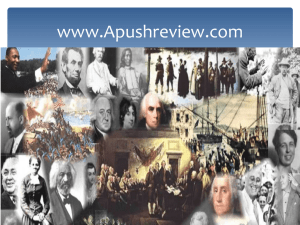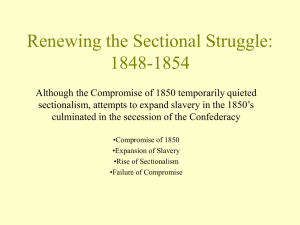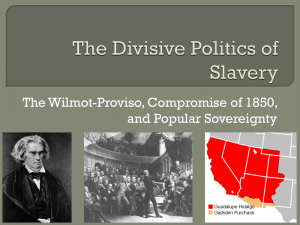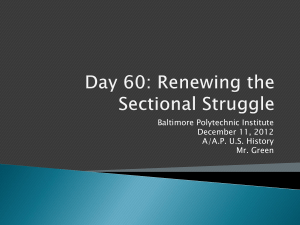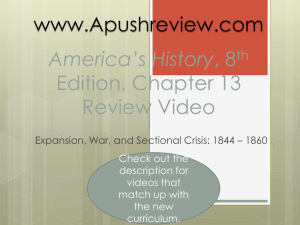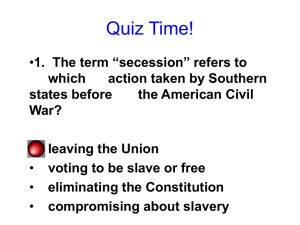AP Exam Review
advertisement
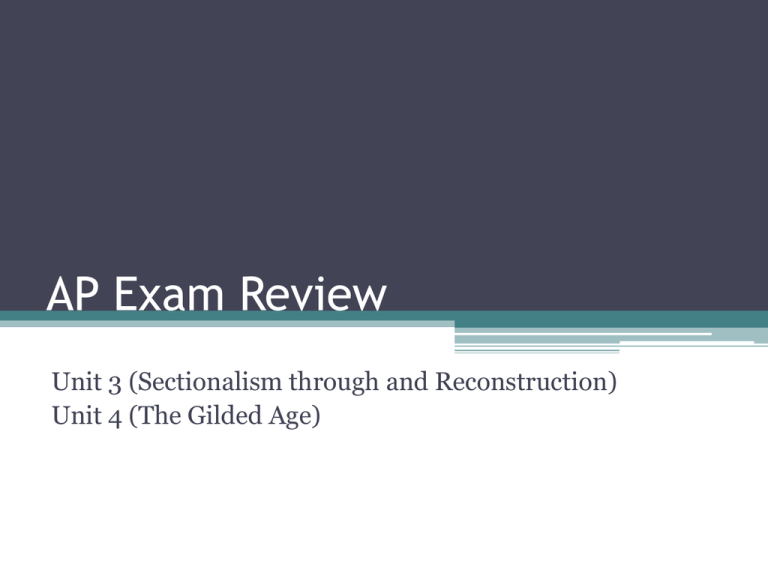
AP Exam Review Unit 3 (Sectionalism through and Reconstruction) Unit 4 (The Gilded Age) Agenda • House Keeping ▫ Review books ▫ Anyone used web resources ▫ Your needs from today • Content via themes • Multiple Choice Practice • DBQ Practice Content Review via Themes • American Diversity: The diversity of the American people and the relationships among different groups. The roles of race, class, ethnicity, and gender in the history of the United States. • American Identity: Views of the American national character and ideas about American exceptionalism. Recognizing regional differences within the context of what it means to be an American. • Culture: Diverse individual and collective expressions through literature, art, philosophy, music, theater, and film throughout U.S. history. Popular culture and the dimensions of cultural conflict within American society. • Demographic Changes: Changes in birth, marriage, and death rates; life expectancy and family patterns; population size and density. The economic, social, and political effects of immigration, internal migration, and migration networks. • Economic Transformations: Changes in trade, commerce, and technology across time. The effects of capitalist development, labor and unions, and consumerism. • Environment: Ideas about the consumption and conservation of natural resources. The impact of population growth, industrialization, pollution, and urban and suburban expansion. Content Review via Themes • Globalization: Engagement with the rest of the world from the fifteenth century to the present: colonialism, mercantilism, global hegemony, development of markets, imperialism, and cultural exchange. • Politics and Citizenship: Colonial and revolutionary legacies, American political traditions, growth of democracy, and the development of the modern state. Defining citizenship; struggles for civil rights. • Reform: Diverse movements focusing on a broad range of issues, including anti-slavery, education, labor, temperance, women’s rights, civil rights, gay rights, war, public health, and government. • Religion: The variety of religious beliefs and practices in America from prehistory to the twenty-first century; influence of religion on politics, economics, and society. • Slavery and Its Legacies in North America: Systems of slave labor and other forms of unfree labor (e.g., indentured servitude, contract labor) in American Indian societies, the Atlantic World, and the American South and West. The economics of slavery and its racial dimensions. Patterns of resistance and the long-term economic, political, and social effects of slavery. • War and Diplomacy: Armed conflict from the pre-colonial period to the twenty-first century; impact of war on American foreign policy and on politics, economy, and society. Content Review via Themes • Brainstorm content related to Unit 3 (Sectionalism through Reconstruction) and try to categorize that content under the themes • Add content from the following list under the appropriate themes Missouri Compromise Texas independence and annexation Population shifting “Cotton is King” “peculiar institution” Abolition William Lloyd Garrison Sojourner Truth Frederick Douglas Stonewall Jackson Ulysses S. Grant Robert E. Lee Jefferson Davis Habeus Corpus Abraham Lincoln Republican Party Crittenden Compromise Eli Whitney Nat Turner Sherman’s March Manifest destiny “54° 40’ or fight” Mexican War Treaty of Guadalupe Hidalgo Free Soilers Gold in California Underground Railroad Harriet Tubman Compromise of 1850 Fugitive Slave Law of 1850 Gadsen Purchase Stephen Douglas Kansas-Nebraska Act Wilmot Proviso Harriet Beecher Stowe “Bleeding Kansas” Know-Nothing Party Dred Scott v. Sandford John Brown Emancipation Proclamation Gettysburg Address Anaconda Strategy Freedmen’s Bureau Andrew Johnson Lincoln’s 10% Plan Wade-Davis Bill Black Codes Radical Reconstruction Johnson’s Impeachment Reconstruction Act of 1867 Ku Klux Klan Amendments 13, 14, 15 Compromise of 1877 Scalawags Carpetbaggers Presidential Election of 1860 The “New South’ Content Review via Themes • Brainstorm content related to Unit 3 (Sectionalism through Reconstruction) and try to categorize that content under the themes • Add content from the following list under the appropriate themes • Write a “evidence statement” for your assigned theme – this will help us see the main ideas from the unit. Content Review via Themes • Brainstorm content related to Unit 4 (The Gilded Age) and try to categorize that content under the themes • Add content from the following list under the appropriate themes Captains of Industry Robber barons Bessemer process Interstate Commerce Act of 1887 trusts Vertical/Horizontal integration Social Darwinism Gospel of Wealth Alexander Graham Bell Thomas Edison Company towns Yellow-dog contracts National Labor Union Knights of Labor Haymarket Riot American Federation of Labor Samuel Gompers Pullman strike Railroad Strike of 1877 Eugene Debs Old/New immigrants Ellis Island Angel Island Tenements Chinese Exclusion Act Eugenics Nativism Transcontinental railroads Homestead Act Barbed wire Reservations Sitting Bull Crazy Horse George Custer Little Big Horn Dawes Act Wounded Knee Farmers Alliance Populist Party “Cross of Gold” Silverites and Goldbugs Crop lien system Sharecropping Plessy v. Ferguson Jim Crow laws Grandfather clause Poll tax Literacy test Ida B. Wells Booker T. Washington W.E.B. DuBois NAACP Credit Mobilier Political machines Boss Tweed Tammany Hall Forgettable Presidents Horatio Alger Emily Dickinson Mark Twain Jack London Barnum and Bailey Buffalo Bill Sears and Roebuck Vaudeville Content Review via Themes • Brainstorm content related to Unit 4 (The Gilded Age) and try to categorize that content under the themes • Add content from the following list under the appropriate themes • Write a “evidence statement” for your assigned theme – this will help us see the main ideas from the unit. Practice MC1 The Republican party originated in the mid 1850s as a sectional party committed to which of the following? A. Opposition to the further extension of slavery into the territories. B. Immediate emancipation of the slaves. C. Repeal of Whig economic policies. D. Restriction of immigration. E. Acknowledgement of popular sovereignty as the basis for organizing federal territories. Practice MC2 President Monroe articulated the Monroe Doctrine in his 1823 address to Congress primarily to A. respond positively to the recent Latin American revolutions B. rule out United States involvement in South America C. provide a rationale for United States intervention in the Isthmus of Panama D. warn European nations against further colonial ventures in the Western Hemisphere E. encourage Britain to help the fledgling Latin American states Practice MC3 The Missouri Compromise did which of the following? A. Prohibited slavery in all the territory of the Louisiana Purchase. B. Provided for admission to the Union of all future states in pairs of one free, one slave. C. Allowed Maine to enter the Union as a free state. D. Finally settled the question of congressional power over slavery in the territories. E. Provided for the annexation of Texas. Practice MC4 Which of the following best describes the situation of freedmen in the decade following the Civil War? A. Each was given 40 acres of land and a mule by the Union government. B. All were immediately granted political equality by the Emancipation Proclamation. C. The majority entered sharecropping arrangements with former masters of other nearby planters. D. They were required to pass a literacy test before being granted U.S. citizenship. E. They supported the passage of Black Codes to ensure their economic and political rights Practice MC5 William Jennings Bryan’s “Cross of Gold” oration was primarily an expression of his A. fundamentalist religious beliefs B. neutral stance toward the belligerents of the First World War C. advocacy of free and unlimited coinage of silver D. opposition to teaching the theory of evolution in public schools E. anti-imperialist convictions Practice MC6 Jacob Riis’s How the Other Half Lives is a study of A. Jim Crow segregation and its effect on African Americans B. the plight of Great Plains farmers in the 1890s C. immigrant urban poverty and despair in the 1890s D. the corruption in city political machines in the 1890s E. the rise of industrial capitalists in the late nineteenth century DBQ Tips • Utilize the same strategies as the FRQ – understand the question, craft a thesis that has a position, categories, analysis, and addresses all parts of the question • Spend some time brainstorming outside information before you read the docs – it will help ensure that your essay is balanced • As you examine the documents, ask yourself “why would they provide this; how does it tie to the question”? – focus on inferences that you gain from the documents and try to connect the documents to outside information • Remember that the documents are presented in chronological order – this is especially helpful with cause and effect, change over time, and comparison essays • Make sure you balance information from the documents and outside knowledge – they are assessing your ability to blend what you know with what they provide • Do NOT describe or quote the documents – the readers can see them • Avoid beginning a sentence with “according to Doc…” – that leads you in the direction of describing • Use as many documents as you can effectively – a minimum of half plus 1 Practice DBQ • In the early nineteenth century, Americans sought to resolve their political disputes through compromise, yet by 1860 this no longer seemed possible. Analyze reasons for this change. ▫ What is the question asking? ▫ Brainstorm outside information. Practice DBQ • Source A: Senator Henry Clay, speech to the Senate, February 12, 1833 “ I merely throw out these sentiments for the purpose of showing you that South Carolina, having declared her purpose to be this, to make an experiment whether, by a course of legislation, in a conventional form, or legislative form of enactment, she can defeat the execution of certain laws of the United States. I for one will express my opinion that I believe it is utterly impracticable, whatever course of legislation she may choose to adopt, for her to succeed… I say it is impossible that South Carolina ever desired for a moment to become a separate and independent state.” • What is the main idea? • How do the author, place, and time help you interpret the document? • How does this document relate to the question? How does it relate to outside information you know? Why did they provide this document? • How can you use the document to answer the question? Practice DBQ • What is the main idea? • How do the author, place, and time help you interpret the document? • How does this document relate to the question? How does it relate to outside information you know? Why did they provide this document? • How can you use the document to answer the question? Practice DBQ • Write a thesis. • Write a support paragraph that incorporates one of the provided documents. • Make sure to provide lots of supporting outside information and clearly link the paragraph back to your thesis. Sample DBQ paragraph • “Between 1820 and 1860 there was a significant shift in the political view on slavery that ultimately led to the collapse of compromise. The Missouri Compromise of 1820 and the Compromise of 1850 were landmarks agreements that Henry Clay engineered to keep the nation together. In that time, the Southern States did not adamantly politicize their stance on slavery. Many, including Henry Clay, believed that despite the significant difference of opinion, these early political disagreements did not truly threaten compromise (Doc A). However, after Northern disgust for the Compromise of 1850 (especially over the Fugitive Slave Law), differences over slavery began to threaten political disintegration. This tension comes forth in the election of 1860 when not a single Southern state voted for Lincoln (Doc H). This political division over the issue of slavery eventually led to Southern secession and thus a collapse in compromise.”

